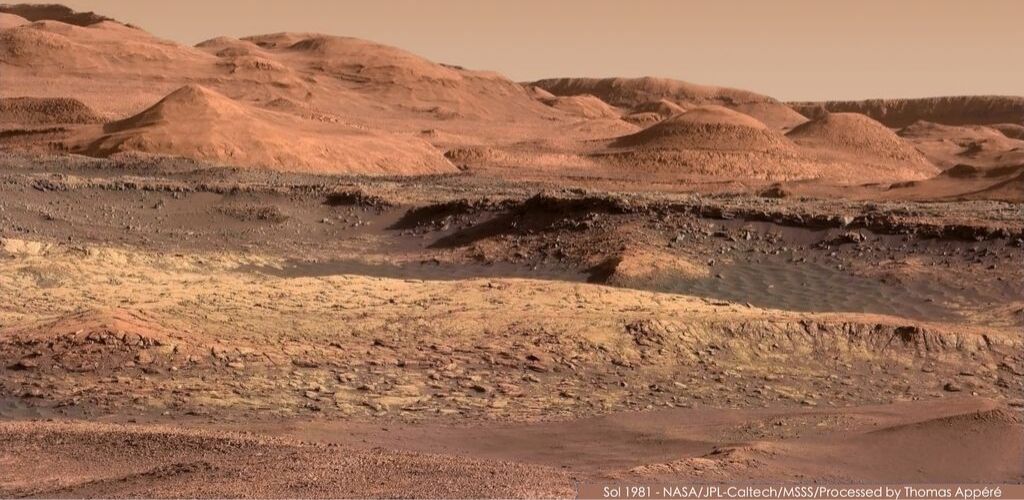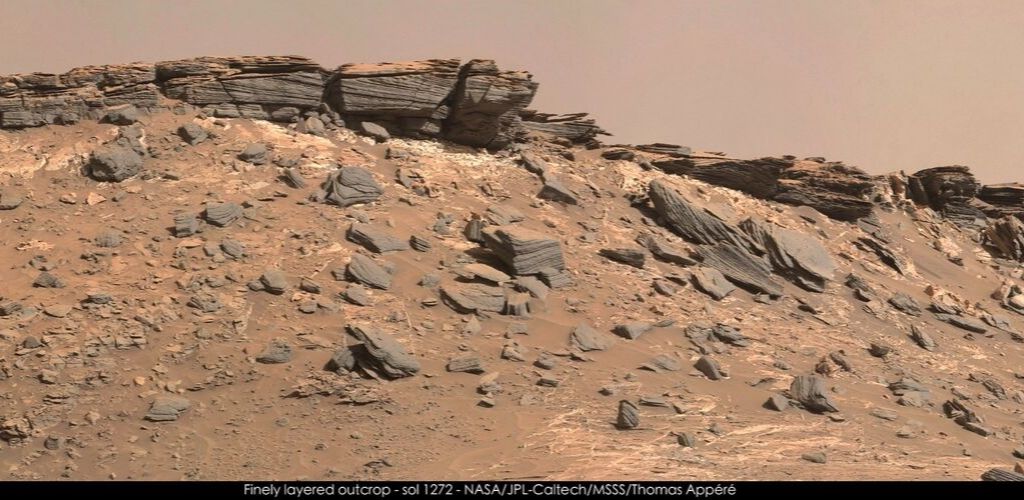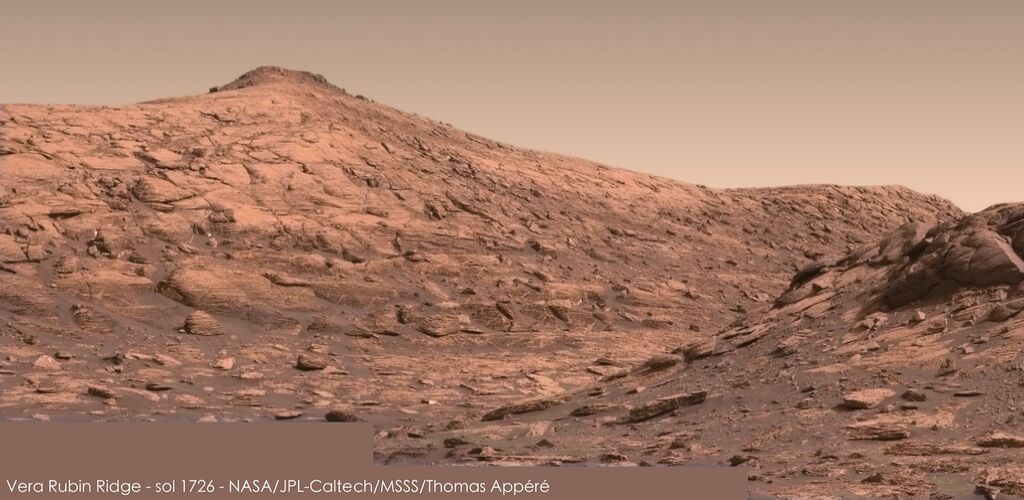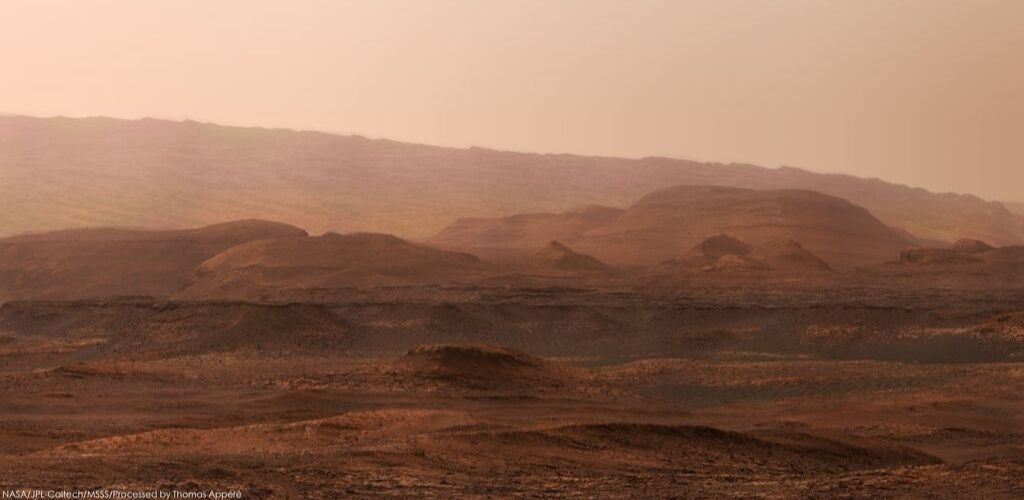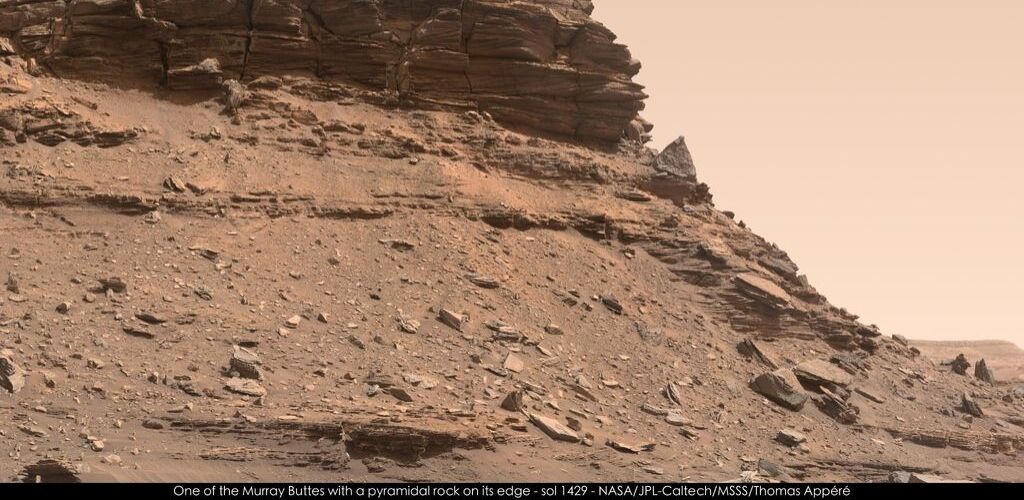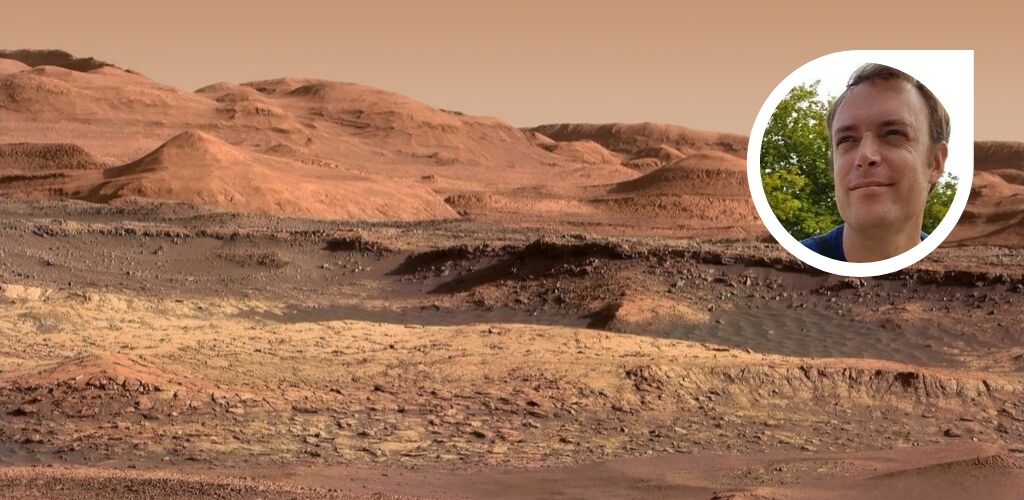
Hi Space Lovers ! Today we are with Thomas Appéré, PhD in Planetary Science, Physics teacher, and image processing expert. He processes images from space, especially from Mars, to make awesome panoramas and 360° pictures so that you can enjoy Mars as if you were there. Thomas answers our questions about its time-consuming but fascinating hobby. Let’s go !
From Space With Love – Hi Thomas and thank you very much for being with us today !
Thomas Appéré – Hi. It’s good to be here !
From Space With Love – So could you please introduce yourself and your work in a few words ?
Thomas Appéré – I’m Thomas Appéré, I’m 35, and my job is to be a physics and chemistry teacher in a high school in France. I’m also PhD in planetary science. And what is interesting here is to talk about my hobby about processing pictures from spacecrafts, rovers and landers. This is one of my favorite hobbies ! I love processing Curiosity pictures, InSight pictures or New Horizons pictures, and so on. So what do I do with this pictures ? I post on the social media. I download these pictures on websites (for example on the NASA website or ESA website. Then I stitch those pictures together to build some panoramas. And I also do some post-processing to adjust the levels of the pictures, the color levels, the contrasts on the basis of the calibrated data in order to show what we would see, what a human eye would see on Mars.
So it’s a kind of immersive experience I propose with these panoramas, and I try to stick to catch with virtual reality experiences to propose a more modern experience, I would say. You are even more immersed in the panoramas, in the landscapes with this virtual reality stuff.
From Space With Love – OK ! Do you mean that your work is also available with 360° virtual reality headset ? We can also view your work with this stuff ?
Thomas Appéré – Yes, exactly. Actually I do this job only for Curiosity. I plan to do it also for example the Chang’e 4 rover and lander, I would like to do so to these 360° panoramas for other spacecrafts but up to now I stick to Curiosity because it’s a lot of work to do and it’s only available, possible when Curiosity rover take a full panorama. It’s possible for example with the Mastcam camera. There are some regular panoramas but the field of view is often restricted to only the direction the rover will take. It’s just to plan the direction of the rover.
But sometimes the Curiosity team decides to image the whole panorama at 360° degree, also what is vertically observable. It observes the wheels of the rover, the deck of the rover and also a bit of the sky. And my job here is to stitch all these pictures, about 100 pictures, together and to give a good experience I also add a sky on Photoshop, so I model of sky with gradients of colors to merge these colors with the colors we observe on the panorama. It’s pretty difficult to obtain a good merging between the sky observed by Curiosity and the sky I model.
And when you have this panorama – 360° panorama horizontally it’s a 360 degree and vertically it’s 180° – then you can put this picture in for example the Roudme website which proposes to upload virtual reality panoramas. When this panorama is available on this kind of website, you can just take your smartphone, go to the website on your smartphone and then display this panorama. There is a way to see it with a splited screen and you can see it with for example Google Cardboard or with virtual reality headset.
From Space With Love – In fact why do you do this ? Is it only a hobby or do you have other goals ?
Thomas Appéré – First it was a hobby. I started it when I was 20. Actually, I witnessed the landing of Opportunity and Spirit when I was in highschool. So I followed the exploration of Mars with these rovers. I followed very actively the updates by the JPL team. And a way to to share my passion for this exploration of Mars was to contribute to a a french website, whose webmaster is Olivier Poch. Currently he is postdoc in Grenoble (France) working on exobiology. He built this website to share his passion about Mars and he proposed that I upload some pictures of Mars, just pictures we find on the NASA website, and to add a few lines of comment to explain what we are seeing and what the rover will do according to the plan.
And then I found a software to stitch pictures together. It was just the kind of software you have with your camera to stitch pictures. So it was very easy to use and I put these pictures from Spirit and I stitched these pictures and I had the whole panorama. So it was a pretty ugly at the beginning ! It was not the kind of panorama I get now, but it was the first step into this image processing hobby to obtain the kind of product JPL obtains but by my own. It’s just a fun hobby to do this.
Actually a funny memory I have about this is that when when I was a young student, I was 20, I printed 20 or 30 pictures obtained by Opportunity inside its crater – it landed into the Eagle Crater I think – and I printed all these 20 or 30 pictures and I sticked them on the walls of my bedroom so that I could make a panorama with just stickers, the pictures next to the others. It was my very first panorama. And then I did this with a computer. It was more easy to share. My first panorama was in my bedroom by sticking pictures together.
And then I did this during several years when I was in an engineering school. I continued this hobby. I had less time but I tried to do this to try to also colorize pictures because Spirit and Opportunity rovers took pictures with color filters, so to obtain the RGB pictures you had to merge the red channel, the green channel and the blue channel so I tried to do this in Photoshop and Gimp. And then when pictures are colored I stitched them together to obtain a panorama or a mosaic.
From Space With Love – You have already talked about these processed images with space agencies, with scientific community to expose or to do a conference perhaps ?
Thomas Appéré – I give pretty often some conferences for public. During these public outreach conferences I present my work but I never gave a conference only about my work, I plan to do this at the end of September. I will give a talk about processing of Mars pictures (Curiosity and InSight pictures) then again it will be near Nantes, in France. And then I will give it also in Nantes in January.
I know that the scientific community is interested by my work but also the work by other people in the image processing community. Several of us process pictures. Maybe if you are on Twitter you see all these guys digging into the pictures we have in the picture archives. We try to download all the raws which are hidden in the whole 10 000 pictures taken by their spacecrafts. And we try to find the good ones, the very pretty good ones, and to merge them together. And when I did the first selfies of Curiosity I tried to make some gifs, some animations of several selfies to show the dust accumulation on the desk of Curiosity.
And I sent them to Ashwin Vasavada who is a scientific investigator of Curiosity. He is in charge of defining the scientific tasks of Curiosity. He was very interested in this animation. A friend of mine, a french scientist goes to conferences Houston about planetary science. He told me that he saw this animation during the conference. It was an honor to know that some scientists use my work to show to their colleagues what we can do with these pictures and what the rover is experiencing (dust recommendations…) with these pictures.
I also kept some contact some with my with my former colleagues. I have a PhD in Planetary Science. So I have engaged in Planetary Science meaning that between 2008 and 2013 I did some research about Mars and I was involved in several space probe projects such as Mars Express and Mars Reconnaissance Orbiter. So I met a lot of planetary scientists, particularly in Nantes in the Laboratory of Planetology and Geodynamics.
And one of them, Stéphane Le Mouélic, is a research engineer who works on ChemCam, a laser which shoot on Mars rocks. He is also involved in the processing of pictures to do some virtual reality with François Civet, who is the CEO of a company which develop some software in virtual reality for space. He’s very interested by my products and we share some experience about this and I know that the scientific community is interested by these products.
These panoramas we do with colleagues, we try to do them before NASA publish their own panoramas. We try to stick to the calendar. When Curiosity takes a picture, usually we can have it a few hours after it is taken. So it’s uploaded on Earth. We download it and we try to do the panorama in the few hours after the pictures are taken and we publish it on Twitter, on a forum such as a the Unmanned Spaceflight forum. And it’s funny to see that a few days later NASA will publish their own panorama, their official one, and usually it’s very close to what we did.
From Space With Love – Let’s talk about the origins : when and how was born your interest in Planetary Science an more generally for space ?
Thomas Appéré – It’s a good question ! I think all astrophysicists like to be asked this question because the interest for space usually drives your life. If you have the virus for space exploration, you like it all your life. And the science topic where there is something new every year : new spacecrafts, new rockets with SpaceX…
My interest for space was born when I was a kid, when I was about 10 or 11. Actually I was with my dad who brought me to a gathering of people observing the stars. I think it was “Nuit des Etoiles” in France (Star Night). I remember I observed Saturn with a telescope and I was thrilled by the fact I observed Saturn and its rings. I was really amazed by the shape of what I observed. It was not just a dot like a star, a star is just a dot of light. Here, it was like a jewel in the telescope and in the sky. It was really unusual to see these circles, these rings. It drew my interest.
Back in school, I read some books about astronomy and then I discovered Mars. I knew that Mars existed but I discovered the huge topography of Mars (It is a similarity with Earth), the fact that maybe life appeared on Mars four billion years ago… It was really exciting to discover all these new landscapes on these conditions very different to conditions on Earth.
From Space With Love – We talked about the origins, let’s talk about the future ! In your opinion, what planet or moon surface should be explored next and why (geologically speaking) ?
Thomas Appéré – It’s the kind of question people who have money ask to planetary scientists because you know, there is not so much money for space, million dollars or euros. It’s not a lot of money compared to military stuffs or other budgets. During a spacecraft mission, you have to pay people. Not only the rockets, not only to spacecraft or the technology, but also all the people involved in these spacecraft missions. So it’s about jobs. When you talk about several million dollars a space mission, you talk about jobs and technology you develop for the public after that.
So when you ask someone what place do we have to study, what place is interesting to study, it’s a really good question because you have to select it carefully. You know that recently the Dragonfly mission was selected to explore Titan with a drone. So it’s a really interesting mission and I am really excited by this mission. So in my opinion, we live in a golden age of space exploration and there are a lot of places still to be explored. We have explored all the major planets of our solar system and Pluto the largest dwarf planet. We have also explored Ultima Thule, one of the KBO (Kuiper Belt Objects). We have also explored several asteroids such as Ryugu and Bennu. We have explored a lot of objects in our solar system.
The question which is currently driving the space exploration is about exobiology, the search for life. Is there life elsewhere in our solar system ? Why life appeared on Earth ? I think they are the two major questions which are driving the space exploration. So to answer this question, I think the most interesting moons or planets are Enceladus, the moon of Saturn with geysers and oceans, energy, organic molecubles or I would say carbon molecules. Actually I try not to use the term “organic molecules” because when you say “organic” to people they think that it’s life. It’s not life, it’s molecules based on carbon. So I prefer saying “carbon molecules”. There is all the ingredients for life to appear and we don’t know if life appeared. that’s accurate. So I think it’s a very interesting place to study.
Also Europe, the moon of Jupiter, and Titan because with all this chemistry in the high atmosphere with precipitations to the surface. It’s a place described as a frozen Earth. Maybe life appeared. I think if life appeared, it’s not on the surface, it’s more on the subsurface, in the ocean below the surface. And it’s really an interesting place to study.
Maybe you are surprised I didn’t mention Mars. Mars is very interesting because it’s a place which was similar to Earth back 4 billion years ago. We have a lot of expectations about life on Mars. We want find fossiles or maybe bacteria. If we find bacteria we have to be sure that it’s not bacteria brought from Earth. So it’s not so easy to assess if life appeared on Mars, but it’s one of the places in the solar system where life maybe appeared but we don’t have liquid water anymore. But you have liquid water in Europe and Enceladus.
Thomas Appéré’s Top 10 for Space Lovers
From Space With Love – Now, please share your top 10 first space lovers. First, could you could you give a space-related place ?
Thomas Appéré – French people know the Cité de l’Espace in Toulouse, in France. I never went to Cité de l’Espace but I would love to experience it, to visit it. There are several devices to experience the Moon gravity, to see a replica of the Curiosity rover which was built by students, really many things about space. I would love to see it.
If I can give you another place related to space, there is the Houston Space Center. I visited it when I was a PhD student. I loved seeing the Saturn 5 rocket, it is exposed horizontally so that we can see the different parts of the rocket. You really experience how it’s huge actually. You see the rocket is so huge. You see the fuel tanks, the rocket engines. It’s really impressive. You also see the spacesuits of the astronauts. There are many things related to space, the American program. It’s very interesting !
From Space With Love – OK ! An experience to live ?
Thomas Appéré – If you love space, what you have to live is the landing of a spacecraft, for example on Mars or one asteroid, with people sharing your passion, with people who are space lovers. It’s really a tremendous, really exciting. During the InSight landing on Mars, I was in my high school. We have a conference room where we can invite people. I invited some people involved in the mission by phone or by Skype. And there was also Marion Massé who is engineer in a planetary science laboratory.

So we presented the mission to the students (my students and the students of my high school), and then there was the countdown to landing and there was a really high pressure in the room. We felt the stress of people. And then the landing occured and all worked perfectly. We were so happy to share it with other people. It’s also really interesting when you see it on your own computer, in your room. But if you are alone it’s not the same thing. If you share it with other people it’s very huge.
Another experience I didn’t lived yet would be to see the launch of a rocket to Mars for example. Also the landing, for example at JPL or in a place where people working on the mission witness the landing. People who designed the instruments of the rover or of the lander. They spent several years working on that particular device and they are very stressed about the mission. If it crashes it’s several years which go to trash. When it works it’s really exciting to share with these people.
From Space With Love – A famous person ?
Thomas Appéré – A famous person in the planetary scientist community, I would mention François Forget, who is a french planetary scientist. He was a kind of mentor for me when I was a PhD student. Actually he’s interested by several planetary objects. He works on the Mars climatology, on exoplanets, Titan… So he works on the atmosphere of almost all planetary bodies which have an atmosphere. Also on atmospheres beyond the solar system.
He has also always a lot of ideas. He loves communicating about his job. He is very easy to communicate with. So you can share with him your ideas, it’s really easy to talk with him. He’s really sweet, really a nice guy. He gives some public outreach talks, so you can see it in a conference, in a talk. I really like this person.
From Space With Love – Do you have a book to share ?
Thomas Appéré – Not one book, but three books : the Mars trilogy by Kim Stanley Robinson. These three books gave me my love for Mars. If you read this book, you really feel like you are on Mars. It’s really well-writen to explain the way we could live on Mars, move on Mars, or if we would terraform Mars how it would occur… It’s a really interesting book about Mars.
From Space With Love – And what’s your favorite movie or series about space ?
Thomas Appéré – About space, I loved Interstellar. It’s not a blockbuster but it was a really good film, I loved it. About a series, maybe the Mars series which was displayed on National Geographic. It was very good to introduce the science about Mars.
From Space With Love – And did you play a space-related game or video game ?
Thomas Appéré – I don’t have the time to play anymore with my hobby. Planetary processing imagery. I don’t have time to play a video game anymore ! But when I was 15 or 16, I used to play Independence War 2 Edge Of Chaos. It’s a game about space, you drive some spacecrafts and you have to explore the universe.
So you can move from one solar system to another solar system. There are a lot of planets to explore. I think that the modern games do the same at an exponential factor. So it was the beginning of these kind of games. I love games where you are free to explore a huge universe. So this game was pretty good for that.
From Space With Love – Do you know good space-related music ?
Thomas Appéré – Since I loved Interstellar, I also love the main theme of Interstellar. I loved it too. I play it when I work, when I do my image processing.
From Space With Love – Would you mention a promising project ?
Thomas Appéré – Not very original : I would say Blue Origin or about the space tourism. Not only because it makes possible to go to space for regular people, but also because I think that the more people will go to space to see the rotundity of the Earth, the Earth from above, the more the consciousness Earth fragility will raise.
I hope that the ecological feeling will increase with more people going to space, not just for fun, not just to experience the 0G, but also to see that Earth is just one small planet in a vast universe and that we are really lucky to have this planet as it is. And we have to protect it.
From Space With Love – In your opinion what’s the most promising country ?
Thomas Appéré – Most promising country in term of space exploration, I think it’s China because China is going very fast in the development of spacecrafts, for unmanned programs and manned programs. My opinion is that China will send the first taikonauts to the Moon before 2030. We can expect a new space race about the Moon.

From Space With Love – Last question ! You talked about Blue Origin, but in your opinion is it the most promising company ?
Thomas Appéré – It depends on what you are speaking about. If it’s space tourism, maybe Blue Origin but you have also SpaceX which is very promising with all its programs not only about space tourism but also space exploration.
Elon Musk says he wants to go to Mars. I think he knows there are a lot of technical difficulties to understand and SpaceX has to go beyond these difficulties. So I don’t think that he can stick to its calendar but it’s still a very promising company with its sucess in landing its rockets. It’s very impressive !

From Space With Love – Allright. Thank you very much Thomas for answering our questions.
Thomas Appéré – Thank you !
From Space With Love – Goodbye !
Thomas Appéré – You’re welcome, goodbye !
Follow Thomas Appéré on
Interview in July 2019
Images by NASA/JPL-Caltech/MSSS/processed by Thomas Appéré

